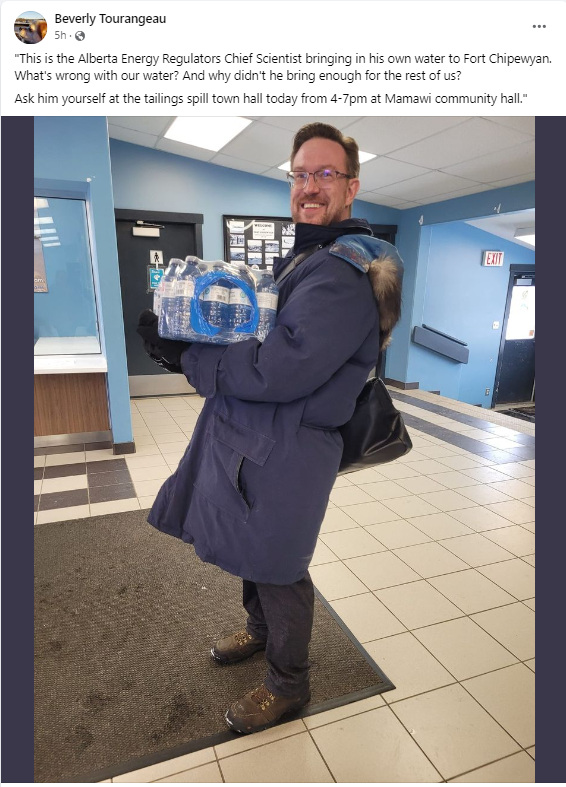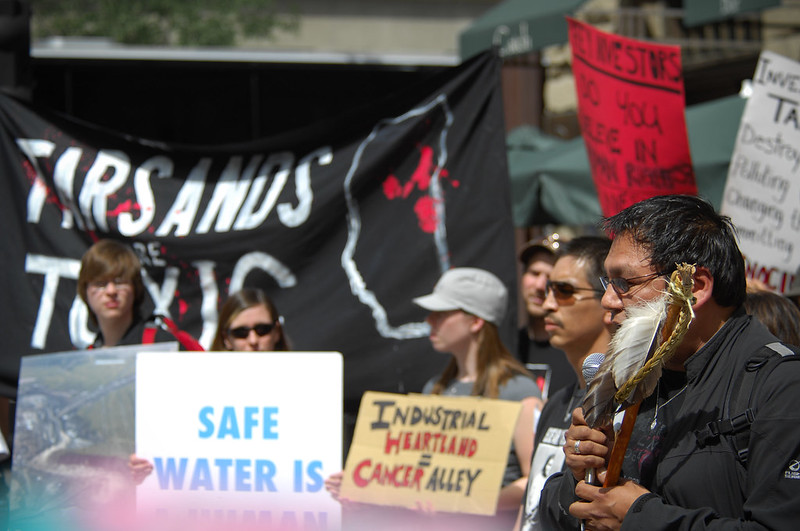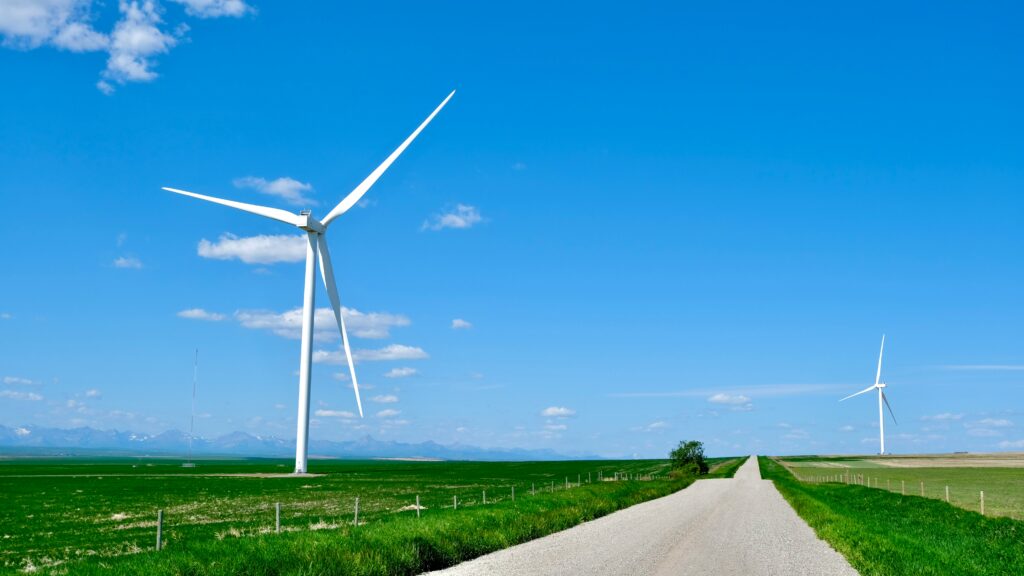A northern Alberta Indigenous community is suing the Alberta Energy Regulator for the effects of an ongoing environmental disaster at an Imperial Oil tar sands mine.
Athabasca Chipewyan First Nation (ACFN) Chief Allan Adam served the CEO of the Alberta Energy Regulator (AER) with a statement of claim indicating his community intends to hold the regulator legally responsible for the aftereffects of the Kearl mine disaster that began in 2022. Chief Adam hand delivered the lawsuit to CEO Laurie Pushor during an AER townhall meeting in Fort Chipewyan on Tuesday March 5.
The lawsuit alleges “negligence, nuisance, breach of the duty to consult, breach of the Honour of the Crown, breach of fiduciary duty, and unjustified treaty infringement by the AER and Alberta against the ACFN.” The nation is seeking $500 million in damages.
The ACFN has constitutionally protected rights to their traditional territory and their traditional way of life, which includes hunting, fishing, trapping, and gathering on their land, as well as access to freshwater resources.
According to the statement, three uncontrolled discharges of industrial wastewater from the Kearl oil sands processing plant and mine resulted in at least 5.3 million liters of wastewater flowing into ACFN traditional territory. This was made public in March 2023. According to the ACFN’s senior manager for intergovernmental affairs, Jay Telegdi, it was at that time that the AER and Imperial Oil first admitted they had known all four of the Kearl facility’s tailings ponds had been leaking since at least May 2022, but did not know for exactly how long, or how much had been leaked. Documents obtained by the ACFN and shared with DeSmog show Imperial was aware their own measurements indicated seepage may actually date back to 2019.
The Kearl facility, which produces diluted bitumen, a heavy crude oil, is one of Canada’s largest open-pit oil and gas mining operations.
300 Square Kilometers of Tailings Ponds
Tailings ponds are artificial bodies of water that contain mine tailings (in the case of oil sands tailings, a mixture of suspended solids, salts, chemicals, water, silt, and residual bitumen, all of which constitute the wastewater that was used during the extraction process). According to Environmental Defence, tailings ponds in Canada now cover some 300 square kilometers, with no credible plans for remediation. In addition, tailings ponds contain hazardous chemicals, such as mercury, benzene, and arsenic.
According to the statement of claim, though the Alberta Energy Regulator knew of the uncontrolled discharges and leaks in 2022 and 2023, the AER failed to inform the ACFN, and neglected to disclose what the potential impact on land or water resources might be. Telegdi told DeSmog the AER initially claimed this was nothing more than a communications issue.
“They only said there was a puddle of rusty water near the tailings ponds,” said Telegdi, arguing that both Imperial Oil and the AER have been purposefully deceptive. The ACFN said they only found out about underground seepage nine months after it started.
“Imperial and the AER are both obligated to communicate spills and leaks, anything over one liter. They didn’t,” said Telegdi.
Imperial Oil did not immediately respond to questions about the leak.
The ACFN’s suit alleges that at no time did the AER reach out to the community, either to consult on mitigation efforts or to notify about the ongoing contamination of their land.
The ACFN told members of their community to stop eating wild food in March 2023, as soon as the AER admitted to the uncontrolled discharges and leaks. The ACFN began distributing bottled water out of concern local water sources were contaminated.

The ACFN has been concerned about the environmental impact of the Kearl facility for some time. In 2007, during the pre-construction environmental impact assessment stage, the ACFN claim they warned the regulator the tailings ponds would likely leak because they were built on porous ground. The ACFN says they were ignored by the regulator, and that the Kearl facility was approved on the basis of a containment system that would pump seepage back into the leaking tailings ponds.
One member of the AER team that visited Fort Chipewyan was photographed carrying a crate of bottled water as he disembarked at the local airport. It didn’t go over well with members of the community, who have been told by the AER that contaminants found in the local water supply are within acceptable limits.
The ACFN further alleges that throughout the summer of 2022, Imperial and the AER worked together on a remediation plan, but never informed the ACFN of what they were doing. In August of 2022, Imperial’s testing revealed that the leaks contained industrial wastewater and that several substances — including arsenic, sulfate, and dissolved iron — exceeded provincial regulatory guidelines for the protection of aquatic life. ACFN was kept in the dark even as Imperial continued attending meetings with the nation, the suit alleges.
While the AER kept quiet about the leaking tailings ponds, ACFN alleges the province collected $50 million per month in royalties from the Kearl facility alone. A spokesperson for Imperial Oil confirmed to the Globe and Mail that the tailings ponds are in fact still leaking but indicated that they do not believe the leaks are negatively impacting either drinking water quality or local fish and game.
“The AER is supposed to regulate the energy sector in Alberta to ensure safety and environmental responsibility,” said Chief Adam in a statement. “They have spectacularly failed on this front. The AER has also neglected ACFN’s constitutional right to be consulted and accommodated. We will always defend our land and Treaty rights. We will see the AER and Alberta in court to answer for what we say are their unconstitutional, negligent, and reckless actions and decisions.”
Tuesday’s meeting was the AER’s first ever meeting in Fort Chipewyan, a predominantly Indigenous hamlet about five hours north of Fort McMurray. The meeting was often tense, as community members hammered Pushor with questions about the regulator’s slow response to the initial disaster as much as the apparent lack of interest in the matter over the course of the last year.
‘Energy Dollars’
Several Indigenous leaders, including Chief Adam and Kendrick Cardinal, president of the Fort Chipewyan Métis, called for Alberta’s tar sands to be shut down.
“When is industry ever going to understand the beliefs of this community?” asked Cardinal, who further argued local Indigenous communities had no use nor need of “energy dollars.”
Several community members expressed their concerns that a spate of recent cancer deaths are linked to the spill. Telegdi told DeSmog that “no one will fund a cancer study” despite half a dozen locals having succumbed to bile duct cancer. Disproportionately high cancer rates were reported in the community in 2009, and an apparently high incidence of rare bile duct cancer was noted the same year. Though there’s no definitive evidence recent cancer deaths in Fort Chipewyan are related to the oil and gas industry or the Kearl spill, it seemed like everyone in attendance at the meeting knew someone who had recently died of cancer.
Pushor had no answer to repeated questions about recent cancer deaths, other than to express his sympathies and to reiterate the importance of transparency.
Alice Rigney, a community member who said she had recently lost a family member to cancer, asked Pushor whether anyone at the AER had been fired or disciplined for not informing her community of the spill. Pushor declined to answer, instead saying that the AER had taken steps to hire more monitors.
Mandy Olsgard, an independent consultant who previously worked as senior toxicologist at the AER, reviewed Imperial Oil’s annual groundwater monitoring report. According to Olsgard, Imperial had not activated its interception system after seepage was detected. Olsgard told DeSmog that, according to the documents she reviewed, it seemed the oil giant had identified the north side of the tailings ponds as having a high probability of leaking. This point had been shared with regulators as early as 2007.
The meeting concluded shortly after Chief Adam served Pushor with the lawsuit notice. Though Pushor and the AER had initially indicated their willingness to take questions from the media, they changed their mind during the meeting. In an email, an AER spokesperson said the regulator could not answer specific questions about an ongoing legal action.
The AER’s response doesn’t impress Jay Telegdi; “why weren’t they able to answer any questions for the past year, before the lawsuit?”
Subscribe to our newsletter
Stay up to date with DeSmog news and alerts







